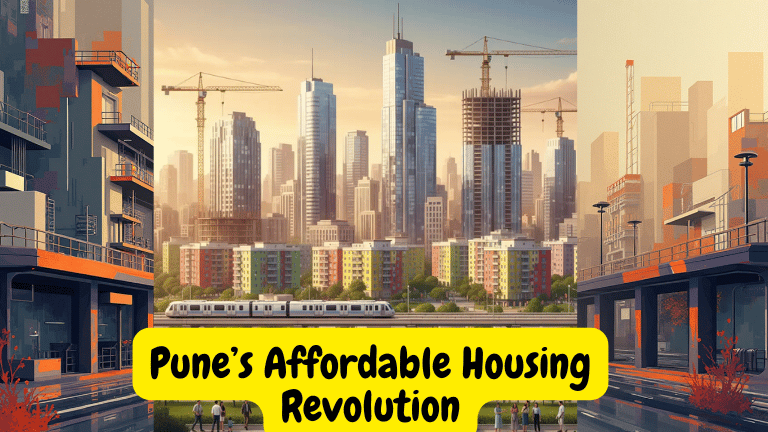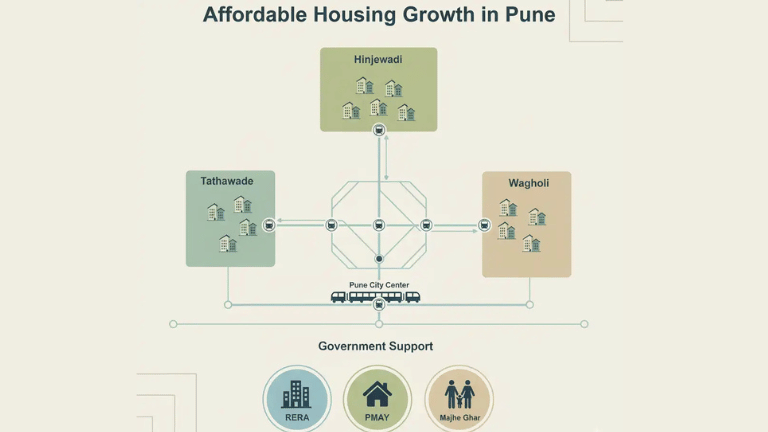Pune’s real estate story has taken a dramatic turn in recent years. Once known for premium apartments and mid-segment homes, the city is now experiencing an unmistakable shift toward affordable housing. This change is not just a reaction to rising costs. It is the outcome of a clear government vision and strong buyer demand. What used to be a city of luxury projects has slowly transformed into a landscape where accessibility and inclusivity define growth.

A Changing Market
Pune has always attracted professionals, students, and families. Its growing IT hubs, universities, and overall quality of life, including trains, metros and cabs, have made it one of India’s most desirable cities. But as property prices climbed, middle-income and lower-income families found homeownership harder to achieve.
That is where policy interventions stepped in. Both central and state governments introduced measures to make housing more affordable. The goal was simple. Turn the dream of owning a home into a realistic plan for more people.
Restoring Confidence Through RERA
The introduction of the Real Estate (Regulation and Development) Act, or RERA, marked a turning point for buyers. By enforcing transparency, setting deadlines, and requiring registration, RERA reshaped buyer confidence.
Earlier, delays and unclear pricing created hesitation among buyers in Pune. Today, a RERA-registered project signals trust. Buyers prefer these projects because they protect against fraud and guarantee better accountability. Developers, too, have adapted by improving compliance and communication.
Majhe Ghar – Majhe Adhikar: Maharashtra’s Landmark Initiative
Among the state’s major housing policies, Majhe Ghar Majhe Adhikar, launched in 2025, stands out as a bold step. With a mission to build 35 lakh homes by 2030 and an allocation of ₹70,000 crore, this program focuses on affordable homes for the economically weaker and middle-income sections.
For Pune, the policy has changed the city’s development map. Suburbs such as Hinjewadi, Wagholi, Tathawade, Ravet, and Punawale are emerging as affordable yet well-connected residential zones. The government’s push for public-private partnerships and quicker approvals has motivated developers to participate actively. As a result, first-time buyers are finally seeing legitimate, regulated, and well-planned projects at achievable prices.
Incentives That Matter
Affordable housing in Pune is not growing by chance. Financial support schemes like the Pradhan Mantri Awas Yojana under the Credit-Linked Subsidy Scheme have made a major impact. By lowering the interest burden on home loans, these subsidies have encouraged thousands of young professionals and families to take the leap toward homeownership.
In addition, stamp duty discounts for women buyers have spurred gender-inclusive investments. Maharashtra’s 1% concession on stamp duty has empowered more women to buy homes in their names. It is both a social and economic change that encourages equality in ownership.
Infrastructure Making Affordability Attractive

Affordable housing in Pune no longer means distant or poorly connected areas. With large-scale infrastructure projects like the Pune Metro expansion, Ring Road, and Smart City Mission, peripheral zones are gaining fast connectivity and amenities.
Developers are designing projects that combine affordability with convenience, giving access to schools, healthcare, public transport, and job hubs. The upcoming Miracle Group Imperio Towers shows how modern architecture, green surroundings, and strong connectivity can coexist in the affordable segment.
Buyers are now evaluating value through connectivity, not just proximity to the city centre. This shift reflects how infrastructure can balance cost and comfort.
Developers Reworking Their Strategies
The transformation of Pune’s housing market has forced developers to rethink their priorities. High-end apartments may still exist, but the real growth is happening in the affordable and mid-income segment.
Builders are now offering compact, functional homes with flexible payment options and timely delivery commitments. Smaller developers, once sidelined by big players, are entering the market with support from government policies and easier financing. The result is a more balanced real estate ecosystem that serves diverse income groups.
A Broader Social and Economic Impact
This new housing wave is not just about bricks and walls. It is about inclusion. Affordable housing has created jobs, improved infrastructure, and built a sense of stability for families who once rented indefinitely. It is also driving sustainable growth and spreading development beyond traditional city limits.
Moreover, government regulations like RERA and schemes like PMAY have built a culture of accountability. Buyers now expect transparency and are confident about long-term investments.
The Road Ahead
Pune’s shift toward affordable housing is reshaping how the city grows and how people live. The combination of progressive policy, active developers, and evolving buyer expectations has created a healthier and more inclusive market.
To maintain this momentum, the focus should remain on consistent policy execution, infrastructure growth, and strong collaboration between the public and private sectors.
If these efforts continue, Pune could become a model city for balanced urban development where affordability meets aspiration and economic progress meets social equity.
Affordable housing is no longer a fallback option. It is the new definition of smart and sustainable living for India’s next generation of homeowners.